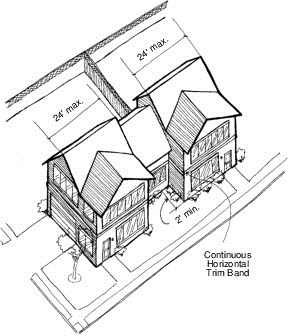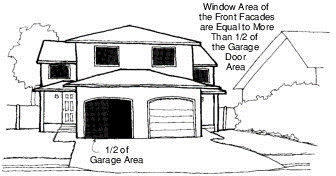Chapter 18.26
MULTIPLEX RESIDENTIAL UNITS – DEVELOPMENT AND DESIGN STANDARDS
Sections:
18.26.020 Multiplex residential development and design standards in the R4-8 zoning district.
18.26.010 Purpose.
This chapter expands the mix of housing opportunities within the city of Sequim by permitting multiplex residential units in the R4-8 zoning district that meet city development and design standards. (Ord. 2022-024 § 3 (Exh. C))
18.26.020 Multiplex residential development and design standards in the R4-8 zoning district.
Unless otherwise stated, the following standards apply to duplex, triplex, and fourplex structures, whether individual or part of a larger project.
A. Multiplex residential development dwellings are allowed as a limited use on a single parcel/lot not smaller than 9,000 square feet for a duplex, 10,500 square feet for a triplex, and 12,000 square feet for fourplex units by approval of an administrative conditional use permit (ACUP). Multiplex projects with two or more buildings must provide at least the same developed area per each building type.
B. Multiplex developments must provide open space.
1. For individual buildings that are not part of a larger development plan, open space may be provided through the establishment of individual yards for each unit. This includes as applicable duplexes, triplexes, and fourplexes.
2. For multiplex projects with more than one building, in any configuration, shared or common usable open space must be provided in addition to any other open spaces or protected areas. Shared or common usable open spaces must include landscaped areas and active or passive recreation opportunities for the residents.
3. Minimum Area Required. Each multiplex project with two or more buildings must provide a minimum of 200 square feet of usable open space for each dwelling unit in the project.
4. Play Space for Children. Multiplex projects with two or more buildings that are anticipated by their type and anticipated residency to accommodate families must provide a safe play space for children. Projects that are established solely for the occupancy of adults are not required to establish play spaces. Such uses may be congregate care facilities, senior-only (over 55) housing developments, and adults-only developments, as permitted by law. The required play space must address the following standards:
a. Play spaces must include play equipment which is manufactured and installed in conformance with the safety standards of the American Play Equipment Industry, or other adopted standards.
b. Play equipment must not be located on a slope greater than four percent in any direction.
c. Play spaces must not include driveways, parking areas, required landscaping areas, or porches, balconies, or overhangs.
d. Play spaces may be established within side and rear yard setbacks, excepting that no play space must be located within 10 feet of any road, driveway or alleyway, parking area, or adjacent single-family resident or single-family residential zone without the provision of fences or buffers.
e. To maximize the personal safety of children residing in the development, play spaces must be located to provide maximum visibility from surrounding multifamily dwelling units and be connected by pedestrian walkways and lighted.
f. Play space should be adequately sized and equipped to be roughly proportional to the anticipated recreational impact.
5. The provision of usable open space, play spaces, and/or recreational spaces within a multiplex project with two or more buildings may be phased concurrent with the approval of a phasing plan consistent with the requirements of this code. Each phase must include usable open space and play spaces (if required) established in proportion to the size and impacts of each phase.
C. Menu Options for Multiplex Front Facade Modulation. At least two of the following architectural design features must be utilized to establish variety in architectural massing which is consistent with and complementary to the scale of single-family houses:
1. Modulating building facade characterized by facade intervals no wider than 24 feet with at least a two-foot offset between each interval;
2. Angled facets, including bay windows, covered entrances, and other similar features projecting out from the front facade at least three feet;
3. Between stories of a building, a change in materials or colors separated by continuous horizontal trim bands, or a recess or projection of at least two feet (credit for this option applies only toward multistory buildings);
Diagram 1: Example of Multiplex Front Facade Modulation
4. Garage doors and front entry doors facing different directions than the doors of the abutting unit(s) in such a manner as to avoid a book-matched or mirror-image design in the facade and so that, in elevation view, the structure’s overall door and window fenestration resembles a single-family house.
D. Menu Options for Treatment of Multiplex Entrances. Multiple entrances to separate units which are visible to the street must include at least two of the following entrance features:
1. Porches protected by a roof overhang or canopy;
2. Wall material within the entryway that is different and distinct from the material of the front facade;
3. Differentiation among front entry designs by such means as variation in porch roof designs, column and balustrade designs, courtyard designs (e.g., courtyard walls, gates, paving, and landscaping), door designs, and (in conjunction with other variation techniques) door colors;
4. Front entry door facing a different direction than the door of the abutting unit(s).
E. Setbacks, lot coverage, and other design requirements for multiplex structures in the R4-8 zone are as set forth in SMC 18.20.050.
F. Multiplex buildings must have a roof pitch no less steep than 4:12 for coverage of no less than 65 percent of the structure.
G. Multiplex Roof Lengths. For all multiplexes exceeding one story in height, no ridgeline can be greater than 24 feet in length without a five-foot vertical or sloped offset that creates a new ridgeline that is at least 10 feet in length.
H. Multiplex Front-Forward Garages. Structures with garages placed forward of the living portion of the dwellings must contain window openings on the front facade, not including openings into the garage, equal to no less than one-half (50 percent) of the surface area of the garage doors.

Diagram 2: Example of Appropriate Multiplex Front Garage Treatment
I. Multiplex structures will be designed to create the appearance, especially on corner lots, of single-family dwelling units through use of height limits, entryway grouping, multi-pitched rooflines, and street-side window openings.
J. Building lot coverage for multiplex residential structures cannot exceed 50 percent. (Ord. 2022-024 § 3 (Exh. C))


